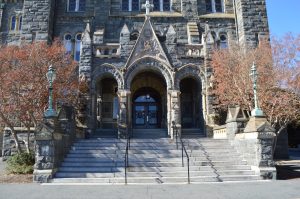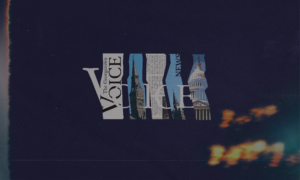Georgetown will conduct its second Campus Climate Survey on Sexual Assault and Misconduct beginning Feb. 1 and running through March 1. Like the first survey in 2016, students will once again have the chance to provide feedback on their experiences with sexual assault and harassment at Georgetown.
Georgetown is one of 33 universities participating in this national survey created by the American Association of Universities (AAU). Its aim is to judge the efficacy of the sexual assault prevention resources and programs that have been instituted since the first survey was conducted.
According to the university’s website outlining the 2016 results, the university initially intended that the next survey would be conducted in 2018. Matt Hill, a spokesperson for the university wrote in a statement to the Voice that delaying a year allows the student body to take the survey in coordination with the other AAU universities. It will also enable the university to judge the impact of the bystander intervention education and training implemented for all first-year students in 2018.
The 2016 survey showed that 31 percent of respondents reported experiencing non-consensual sexual contact due to physical force or incapacitation, yet just 24.5 percent of respondents reported that they knew where to find help on campus after sexual assault or misconduct. The percentage of respondents who reported experiencing sexual assault or misconduct was eight percentage points higher than the average among universities who took a 2015 AAU survey.
Jenn Wiggins, assistant director for sexual assault response and prevention services in the Office of Health Education Services (HES), said one of the drawbacks of waiting the extra year was losing the opportunity to compare a larger sample size of students.
“You hear other folks saying that there’s no difference between two years and three years. I think for me I would have preferred to see two years because what happens is we’ve missed students who would have been here for the first and second survey,” Wiggins said. “I would be interested in being able to compare the same groups versus adding another group to the mix. So for students who took it, we won’t ever know if any of those things really worked for them.”
Georgetown yielded one of the highest response rates in the country for the 2016 questionnaire. Rosemary Kilkenny, vice president of institutional diversity and equity, wrote in a statement to the Voice that there was a 62 percent response rate among undergraduate students, and a 51 percent response rate for all undergraduate, graduate, and professional students. She noted Georgetown’s response rate far outpaced the average participation rate of 19 percent from the 27 colleges and universities who administered the survey in 2018.
In the past few years, the Sexual Assault and Misconduct Advisory Committee (SAMAC) has taken steps to implement the recommendations put forth by a task force formed in response to the results of the 2016 survey. Those results showed that only half of students who reported seeing sexual assault or misconduct intervened in the situation. The 2017-2018 school year was the inaugural year of mandatory, in-person “Bringing in the Bystander” training for all first-year undergraduate and transfer students, which yielded a 99.7 percent completion rate. SAMAC also continued ongoing training for GUPD’s Sexual Assault Response Team officers, proposed language for faculty to incorporate into their syllabi outlining sexual assault counseling and reporting resources, and hired a new staff clinician in HES, wrote Kilkenny.
But Claire Bernstein, the new staff clinician hired in February 2018, resigned in December. Wiggins said HES has started the process of setting up phone interviews to fill the vacancy. Additionally, Georgetown has yet to hire a Title IX coordinator since the previous coordinator stepped down in June of last year. The vacancy has raised concerns from students. Five students wrote an open letter to university administrators in August claiming that the university’s failure to fill the position shows it does not prioritize addressing sexual assault. Students have also questioned the vacancy at town halls on Title IX regulations.
The results of the upcoming survey should be interpreted with caution, Wiggins said. She noted that research on the prevalence of sexual assault suggests that the survey may show a more elevated rate of sexual misconduct this year than in previous years. “The more education we do, the more students will be able to define their experiences, so the chance of the numbers going up is something we have to be mindful of.”
Hill wrote in an email to the Voice that the survey contains many Georgetown-specific questions. Yet Wiggins added that financial constraints limited the university from customizing the survey. “We’re really talking a lot of money, thousands of dollars, to edit it,” Wiggins said. “We ended up not making many edits to make it any different than the cookie cutter form.”
This year’s survey will be nearly identical to the one in 2016. “The survey includes most of the same questions as the first to provide us with reliable data comparisons but also includes refinements to improve the user experience and provide insights about how we can strengthen our efforts to prevent and address sexual misconduct,” Kilkenny wrote.
Relying on the standard form will allow the university to compare data with the 32 other universities participating in the survey this year, but Wiggins said that without more customization, the university will not be able to pinpoint the effect of specific campus initiatives. Instead, the survey will only shed light on the school’s overall progress in addressing sexual misconduct.
Wiggins said that future surveys should address Georgetown’s club and party culture. She hopes the survey’s sponsors will add questions to target how students are finding resources to receive counseling or medical care and report sexual misconduct, and why they choose the resources they do.
In some cases, Georgetown’s data did not match national trends, which Wiggins believes may indicate methodological issues with the survey. She noted that, while national data shows that black women experience sexual assault at higher rates than white women, Georgetown’s 2016 results did not show that black women experience sexual assault at a higher rate than women generally.
Wiggins believes the 2016 survey had much room for improvement in recognizing the voices of minority communities. “We know there are systemic issues in why folks may not take a survey. We know that communities on the margins are less inclined to take a survey due to different oppressive systems,” Wiggins said. “Am I going to complete this survey when I know that this system doesn’t support me? If I don’t have trust for the system why would I complete the survey?”
Wiggins hopes that students of color, those who identify as having a disability, LGBTQ students, and international students participate in this year’s survey.
As the advisor for Sexual Assault Peer Educators (SAPE), Wiggins said that SAPE plans to encourage participation of different populations within the Georgetown community. Wiggins said that one goal is to demonstrate to these groups why the survey is important for their communities and not just beneficial for the university as a whole.
The university will continue to use social media to publicize the survey, though Kilkenny hopes students will play a significant role, too. “Student leaders can talk about the importance of participation before a club meeting, post about it on social media, and encourage peers to spread the word,” Kilkenny wrote.
Hill wrote that the findings from the upcoming survey will be instrumental in the university’s ongoing work to understand how sexual misconduct affects our campus and promote a climate of safety, care, and respect.
Wiggins hopes students will engage with the survey and realize the importance of having concrete data about sexual assault in our community.
“I think a lot of people don’t realize that something like having a campus climate survey gives students the ammunition they need to hold the university accountable.”
The Voice is currently carrying a paid advertisement from the university promoting the upcoming Campus Climate Survey.




